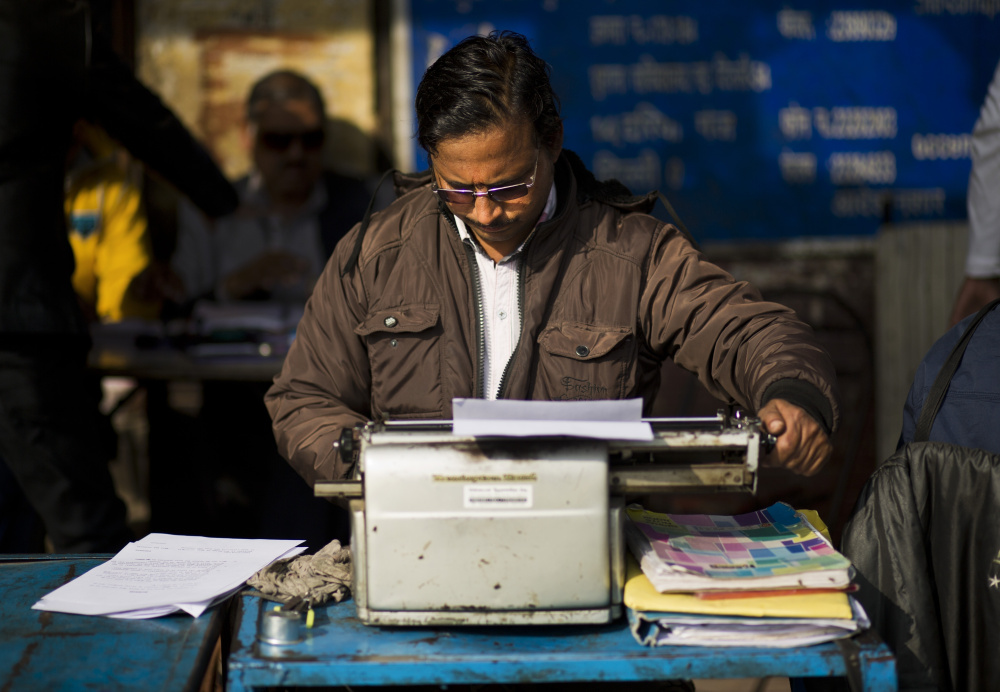NEW DELHI — The end is coming, though admittedly it may not look that way at 10 a.m. on a Tuesday morning, when dozens of young Indians have arrived for morning classes at Anand Type, Shorthand and Keypunch College, and every battered Remington is clattering away.
Looking around the cramped classrooms, you might think that the typewriter still has a future in India. But in one of the last places in the world where it remains a part of everyday life, twilight is at hand.
Even Sunil Chawla will tell you that, and he’s kept Chawla Typewriter going long after the profits disappeared.
“We thought this business would go on forever and ever,” said Chawla, a courtly man whose father founded the family company nearly 60 years ago, but whose own sons chose to avoid the typewriter business. “I’ll keep it alive as long as possible. But after me, I don’t know what’s going to happen. There’s no future in this business.”
For now, only one thing keeps him in the business: “I’m a typewriter man,” he said. “I still have a soft spot for them, and I don’t want to let it go.”
Plus, people do continue to send him typewriters to fix, though most of his work these days is selling supplies for copiers and laminating machines.
India still has a few thousand remaining professional typists. There are a handful of typewriter repairmen and stores selling spare parts. There are typing schools that, at least occasionally, are jammed with students. There are long-outdated government regulations that, for now, help the typewriter cling to life.
But for how long?
“I come here only to pass the time,” Satinder Kumar said on a recent afternoon at Tis Hizari, New Delhi’s main court complex, where 50 or so typists earn a few dollars a day preparing rent agreements, sales contracts and other legal documents.
Kumar worked for 41 years at Tis Hizari, raising two children on his pay.
“It was such a good job. We were working from morning until night,” he said, slouching in front of his manual Remington, a purple beret pulled down over his head to keep out the winter chill. “S.K. Kumar (typist)” it says on a hand-painted sign hanging above what counts as his office, a rusted metal desk in the complex’s yard.
Now, there are just 10-15 pages a day for the hundreds of lawyers scurrying through the maze of buildings and corridors. At 15 rupees a page, or about 20 cents, that barely pays for transportation to work, typewriter ribbons and an occasional tuneup from the complex’s last typewriter repairman. For the typists, things only get busy when all the computers are in use, or there’s an electricity outage.
Technology changes constantly. Jobs die out regularly. Did journalists write about the decline of the video store rental clerk? Did we mourn the end of the LED watch?
But there’s something different about the typewriter, which for more than a century was so important to how the world communicated. It was how presidents issued orders, how Hemingway wrote books, how reporters filed stories. Everything from painfully dull memos to deeply erotic love letters were crafted on typewriters.
In India, the typewriter was never just a piece of office equipment. It was a sign of education, of professional achievement, of women’s growing independence as they slowly entered the workforce. It’s been a Bollywood plot line and a symbol of nationalism (”The all-Indian Typewriter embodies the latest advances,” read a 1950s advertisement for Bombay-based Godrej typewriters.)
Even today it can be a path to success. In a country where government jobs have long been tickets to the middle class, thousands of Indians will sometimes apply for a single clerical position. And while most government offices have shifted to computers for typing tests, some still require a typewriter.
Send questions/comments to the editors.



Success. Please wait for the page to reload. If the page does not reload within 5 seconds, please refresh the page.
Enter your email and password to access comments.
Hi, to comment on stories you must . This profile is in addition to your subscription and website login.
Already have a commenting profile? .
Invalid username/password.
Please check your email to confirm and complete your registration.
Only subscribers are eligible to post comments. Please subscribe or login first for digital access. Here’s why.
Use the form below to reset your password. When you've submitted your account email, we will send an email with a reset code.